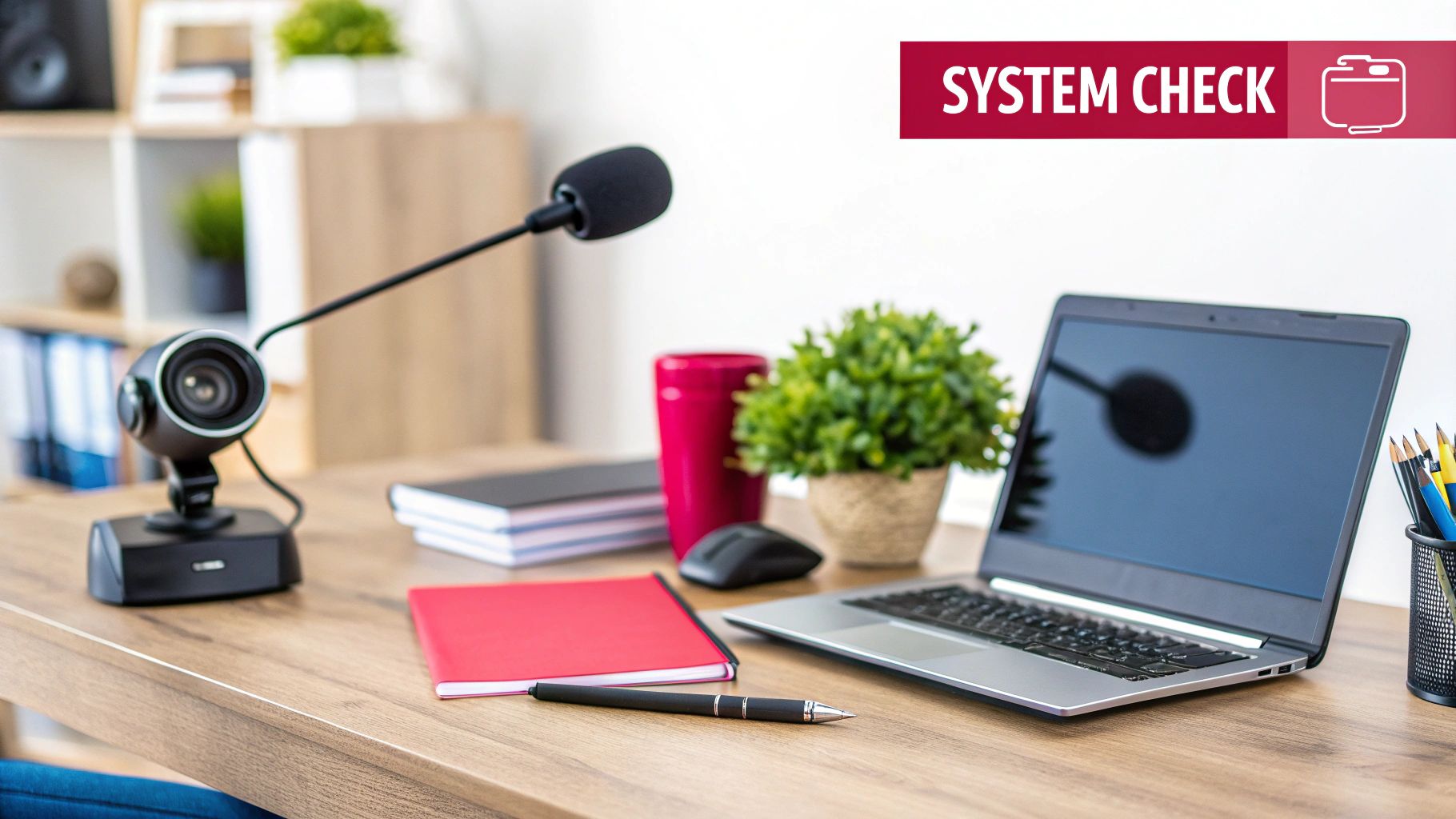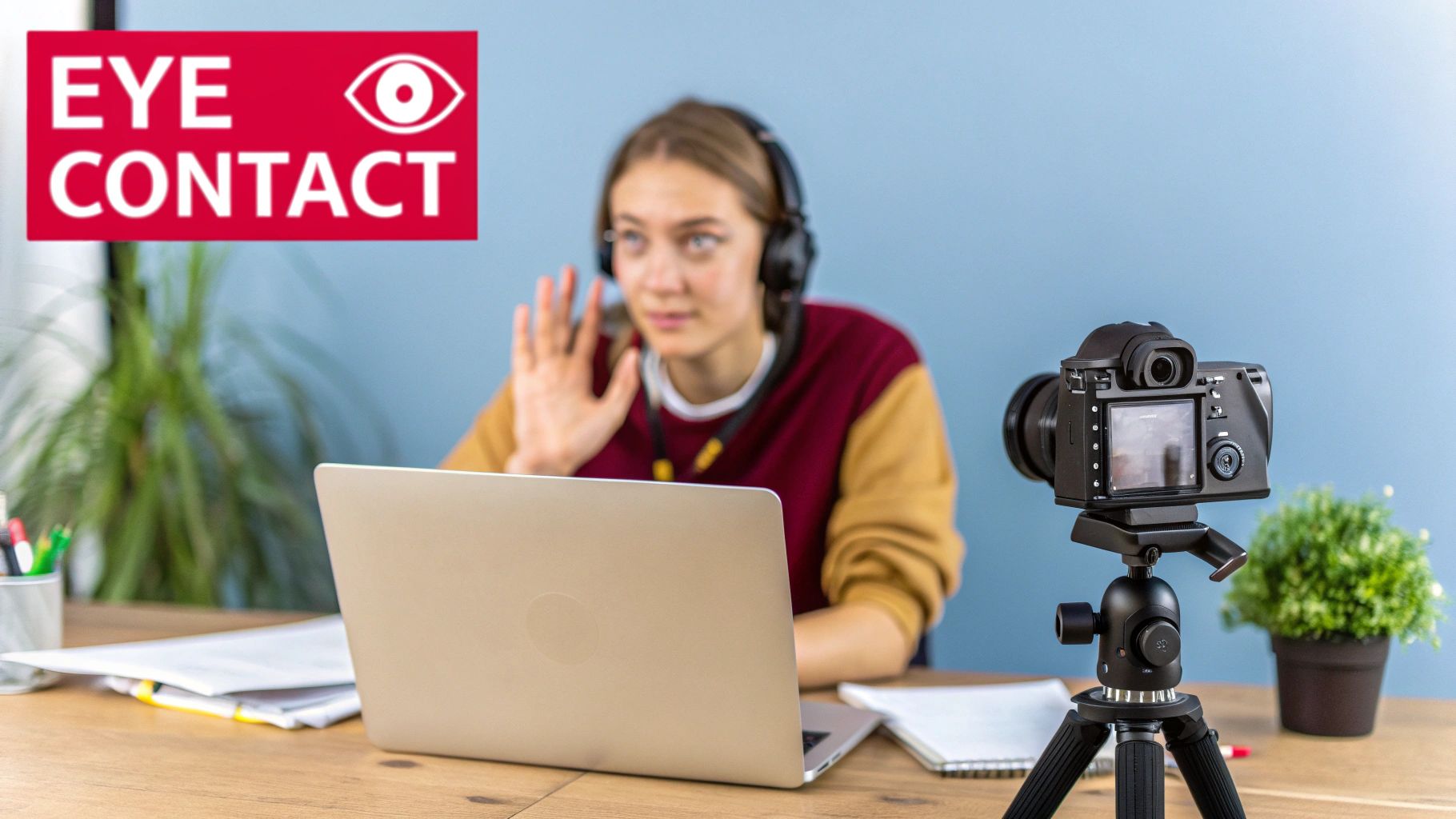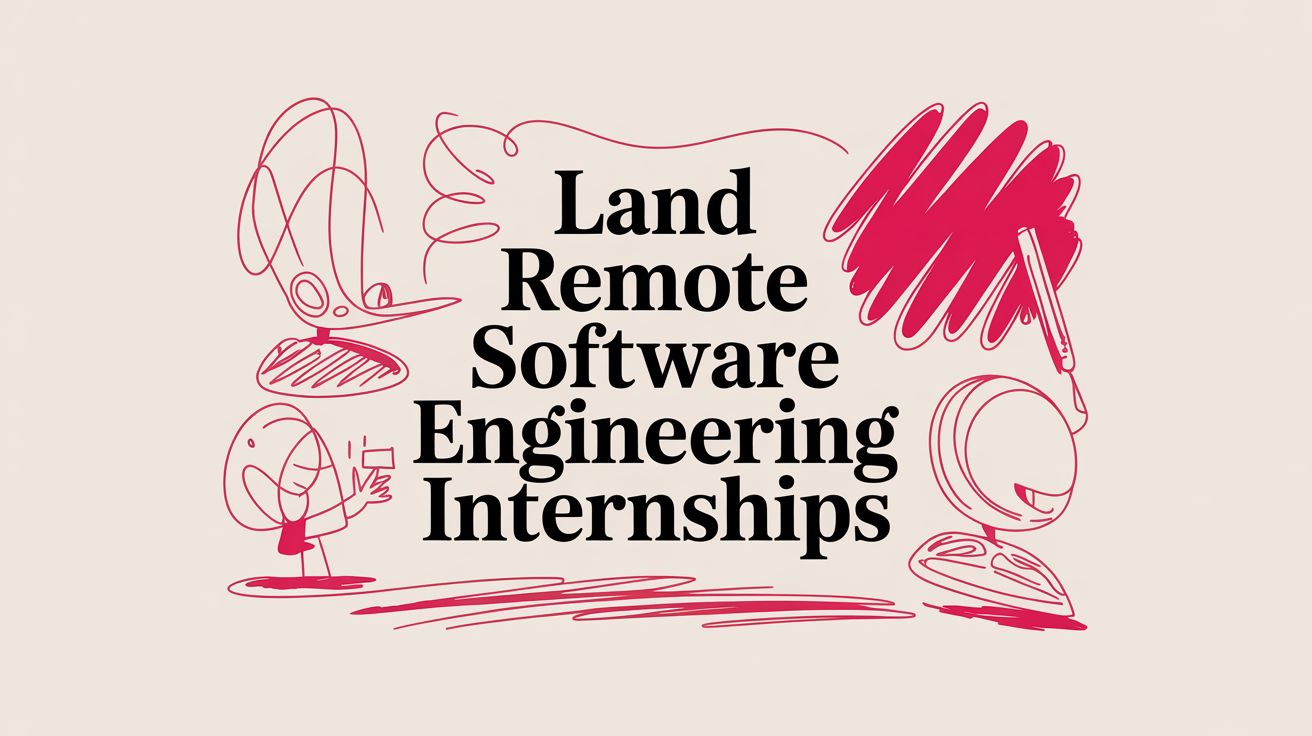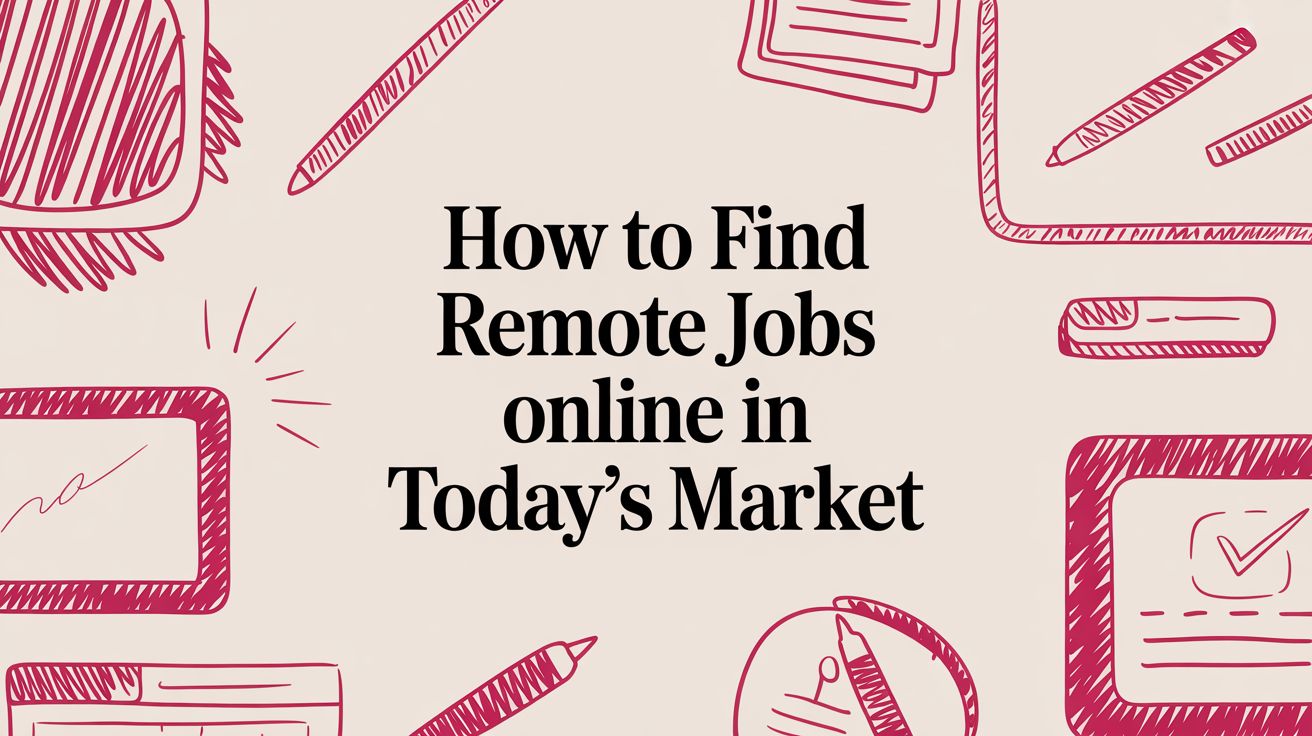7 Tips for Virtual Interviews: Ace Your Remote Job Hunt
Max
Level Up Your Remote Interview Game
This listicle provides seven essential tips for virtual interviews to help you ace your next online meeting and land that remote job. Mastering these tips will ensure you present yourself professionally, avoid technical hiccups, and communicate effectively, giving you a competitive edge. Whether you’re a seasoned remote worker or new to virtual interviews, these tips for virtual interviews cover everything from tech setup to body language. Learn how to create a professional environment, dress for success, and communicate with confidence on camera. Let’s get started!
1. Test Your Technology in Advance
Acing a virtual interview starts long before the call begins. The first, and perhaps most crucial, step to a successful virtual interview is thoroughly testing your technology. This means checking every aspect of your setup to ensure a seamless and professional experience. This includes verifying your internet connection stability, confirming your video conferencing software works correctly, checking your camera and microphone quality, and ensuring any additional tools needed for the interview (like screen sharing or a digital whiteboard) are functioning as expected. By proactively addressing potential technical hiccups, you can project confidence, minimize stress, and focus on showcasing your skills and experience.

This pre-interview system check is a critical component of successful virtual interviews. It involves a detailed assessment of your audio/video quality, ensuring your chosen software is up-to-date and that you’re familiar with its features. It also means having a backup plan in place should any unexpected issues arise. This preparation prevents technical disruptions during the interview, reduces stress and anxiety, and allows you to focus on the content of the conversation rather than troubleshooting technical problems. It also demonstrates professionalism to the interviewer. While it does require a time investment beforehand and some technical knowledge, the benefits far outweigh the drawbacks. You might encounter issues outside your control, like internet service provider problems, but even in these situations, having a backup plan will prove invaluable.
For example, a software engineer candidate, after testing her setup, discovered her microphone wasn’t working correctly. This allowed her time to borrow a higher-quality microphone before the interview, ensuring clear communication. In another instance, a marketing professional practiced using the specific video conferencing platform (Zoom) employed by the company. This pre-interview practice allowed him to seamlessly share his portfolio during the interview, showcasing his work effectively. These examples highlight how testing your technology in advance directly impacts the success of virtual interviews, contributing to a more confident and productive interaction.
Here are some actionable tips to effectively test your technology before your next virtual interview:
Conduct a full test run 24 hours before the interview: This provides ample time to address any unforeseen issues.
Have a friend do a mock interview: Simulating the actual interview environment provides a realistic test of your setup.
Download any required software updates in advance: Outdated software can cause compatibility issues and unexpected problems.
Keep technical support contact information handy: In case of unexpected issues, readily available support can be crucial.
Have a backup device (phone, tablet) ready in case of emergency: A secondary device can save the interview if your primary setup fails.
Test in the same location and at a similar time of day as the actual interview: This will help identify any potential lighting or internet connectivity issues specific to that time and place.
This approach is especially valuable for tips for virtual interviews, making it a must-have on this list. Promoted by LinkedIn career experts, remote work advocates like Lisette Sutherland, and HR technology companies like HireVue and Zoom, the importance of testing your tech is widely recognized. Explore resources for optimizing your remote work setup. Taking the time to test your technology thoroughly can significantly improve your chances of making a positive impression and landing your dream job.
2. Create a Professional Environment
Your virtual interview backdrop is your digital handshake. Just as you’d dress professionally for an in-person interview, creating a professional environment for your virtual interview is crucial for making a strong first impression. This demonstrates respect for the interviewer’s time and highlights your seriousness about the opportunity. A polished and professional setting communicates preparedness, attention to detail, and a commitment to excellence – qualities highly valued by employers. This is a key tip for virtual interviews because it directly influences how the interviewer perceives you and your suitability for the role.

A professional environment encompasses several key features: a neutral, uncluttered background; appropriate lighting; minimized noise and distractions; an organized desk space; and consistent professional appearance. By controlling these elements, you project an image of competence and focus. For example, a financial analyst candidate who set up a temporary home office corner with neutral wall art and good lighting received compliments on his professional setup, immediately setting a positive tone for the interview. Similarly, a teacher who successfully interviewed by converting a closet into a quiet, well-lit interview space when the rest of her home was noisy demonstrated resourcefulness and commitment.
Pros:
Projects professionalism: A dedicated and organized space conveys a strong professional image.
Eliminates distractions for both parties: A clean, quiet environment minimizes interruptions and allows both you and the interviewer to focus on the conversation.
Improves video quality with proper lighting: Good lighting enhances your video quality, making you appear clearer and more engaging.
Demonstrates preparation and attention to detail: Taking the time to create a professional setting shows you are prepared and detail-oriented.
Cons:
Not everyone has ideal home spaces: Limited space or shared living situations can make creating a perfect backdrop challenging.
May require rearranging furniture or purchasing equipment: Achieving optimal lighting and a clean background might involve some effort and expense.
Environmental factors may be difficult to control: Unexpected noises or interruptions can occur despite your best efforts.
Tips for Creating a Professional Virtual Interview Environment:
Lighting: Position your light source in front of you, not behind. This illuminates your face and prevents you from appearing as a silhouette.
Background: Test how your background appears on camera before the interview. A blank wall, a bookshelf with neatly arranged items, or a simple houseplant can work well. Use a virtual background if your physical space isn’t ideal, but test it thoroughly beforehand to ensure it looks natural and doesn’t glitch.
Sound: Inform household members about your interview to minimize interruptions. Consider using headphones with a built-in microphone to improve audio quality and reduce background noise.
Organization: Keep your desk organized with only interview essentials visible. This minimizes distractions and projects a sense of order.
Appearance: Dress professionally from head to toe, maintaining consistency with your on-screen presence.
By following these tips for virtual interviews, you can create a professional environment that strengthens your first impression and sets you up for success. This attention to detail can be the differentiating factor in a competitive job market.
3. Dress Professionally from Head to Toe
While the convenience of virtual interviews allows for a more relaxed setting, maintaining a professional appearance from head to toe remains a crucial aspect of success. This approach, popularized by image consultants like Sylvie di Giusto and career coaches alike, goes beyond simply dressing for what’s visible on camera. It fosters a professional mindset, enhances confidence, and prepares you for unexpected situations. Dressing fully professionally signals respect for the opportunity and the interviewer, demonstrating your commitment to the process, just as you would for an in-person interview. This seemingly small detail can significantly impact how you present yourself and how seriously your candidacy is perceived. It’s a key element in making a strong first impression and maximizing your chances in a competitive job market.

For example, imagine a candidate who had to unexpectedly stand up during a virtual interview to adjust their camera. Had they opted for comfort over professionalism from the waist down, this could have created an awkward and unprofessional moment. In contrast, another candidate, a banking professional interviewing for a leadership position, found that her polished, head-to-toe professional attire helped project confidence and poise, even under the pressure of a high-stakes virtual interview. This seemingly small detail contributed to a successful outcome.
Successfully implementing this tip for virtual interviews involves understanding the specific requirements of your target industry. While a suit and tie might be appropriate for a corporate role, a more business casual look might suffice for a position in a creative field. Regardless of the industry, the key is to project professionalism and attention to detail.
Here are some actionable tips to help you dress professionally for your next virtual interview:
Research the company culture: Understanding the company’s dress code can guide your attire choices. Aim to dress slightly more formally than their everyday standard.
Choose solid colors: Solid colors tend to appear better on camera than busy patterns, which can sometimes distort or create a distracting visual effect.
Avoid overly bright colors or distracting jewelry: These can draw attention away from your face and message.
Prepare your outfit the day before: This reduces stress on the day of the interview and allows time for any last-minute adjustments.
Consider your background: Ensure your clothing contrasts appropriately with your background to avoid a “washed-out” appearance.
While dressing fully professionally may seem unnecessary for tips for virtual interviews where only your upper body is typically visible, the benefits far outweigh the perceived inconvenience. The psychological impact of dressing professionally can significantly boost your confidence and help you project a polished and professional image. It also demonstrates respect for the interviewer and the opportunity. While professional attire may be less comfortable than casual clothing, the potential impact on your interview performance makes it a worthwhile investment. This practice ensures preparedness for unexpected situations and reinforces a professional mindset, ultimately increasing your chances of landing your dream job.
4. Practice Effective Virtual Communication
Acing virtual interviews hinges on mastering the art of effective digital communication. Because video calls lack the nuances of in-person interactions, you must be deliberate in how you present yourself. This involves adapting your communication style to bridge the physical distance and ensure your message resonates clearly. It means being mindful of how you appear on camera, how you speak, and how you engage with the interviewer. This conscious approach can significantly impact how you’re perceived, making the difference between a successful interview and a missed opportunity.

Effective virtual communication requires specific skills like maintaining eye contact by looking directly at the camera, not the screen. This technique creates a sense of connection with the interviewer, mimicking the direct eye contact valued in face-to-face conversations. Speaking clearly and at a deliberate pace is also essential, especially if there are connection issues. Think about pacing yourself about 10% more slowly than you would in person. Conscious body language, such as nodding and smiling, demonstrates engagement and reinforces your message. Adapting your non-verbal cues to the digital environment can further enhance your communication. For example, sitting slightly further back from the camera can improve your framing and create a more professional appearance.
The benefits of mastering virtual communication are numerous. It helps you create a genuine connection with the interviewer despite the physical distance, effectively compensating for the limitations of video calls. Demonstrating digital communication competence signals professionalism and preparedness, which are highly valued in today’s remote-centric world. Clear and concise communication also minimizes misunderstandings, ensuring your qualifications and enthusiasm are conveyed accurately.
Consider these examples: A sales manager candidate who diligently practiced looking at her camera instead of the screen received positive feedback on her exceptional engagement throughout her interviews. Similarly, a customer service representative candidate whose clear articulation and appropriate pauses helped overcome connection issues during his interview left a lasting impression. Practice Effective Virtual Communication
While adapting to virtual communication can feel unnatural initially, the effort is well worth the reward. It may require overriding some natural conversation instincts, such as looking directly at the person on screen, but with practice, these techniques become second nature. To improve your virtual communication skills, place a small sticker near your camera as a visual reminder to look there. Practice with recorded mock interviews to review your communication style and identify areas for improvement. Allow for slight pauses during the conversation to prevent inadvertently talking over the interviewer due to lag. Effective communication is key during virtual interviews. For more in-depth tips on virtual communication and collaboration strategies, check out this helpful resource: virtual collaboration best practices. This resource from Bulby offers valuable insights for enhancing your online communication skills. By following these tips for virtual interviews, you can confidently present your best self and significantly increase your chances of landing your dream remote role.
5. Prepare Notes But Don’t Over-Rely on Them
One of the biggest advantages of virtual interviews is the ability to have notes nearby. This can be a game-changer when it comes to remembering key talking points, metrics, or specific examples. However, this advantage can quickly become a detriment if you over-rely on your notes. Finding the right balance between strategic preparation and natural engagement is crucial for a successful virtual interview. This is why preparing notes, but not over-relying on them, is a vital tip for virtual interviews.
This method involves strategically preparing concise notes that enhance your responses without making you appear disengaged or robotic. It’s about using them as memory joggers, not scripts. A discreet reference system allows you to quickly glance at your notes and seamlessly incorporate the information into your conversation. This balances preparation with the natural flow of a conversation, ensuring you present yourself as authentic and engaged. Key talking points should be organized logically to facilitate quick and easy access during the interview.
For example, a product manager preparing for a virtual interview could place sticky notes around her monitor with key accomplishments categorized by project or skill. This allows for a smooth, natural reference when discussing relevant experience. Similarly, a software developer could create a one-page document with project metrics, allowing him to provide specific, data-driven answers to technical questions. These examples demonstrate the power of strategic note preparation in virtual interviews.
Pros of this approach:
Provides memory support: Interviews are high-stress situations. Having notes can reduce anxiety and help you remember important details.
Allows for precise preparation: Notes enable you to prepare specific answers to anticipated questions and highlight key achievements you want to emphasize.
Reduces anxiety: Knowing you have a backup plan can significantly reduce interview nerves.
Helps structure detailed responses: Notes can help you structure complex answers and avoid rambling.
Cons of over-reliance on notes:
Can appear disengaged: Constantly looking down at your notes can make you seem disengaged and uninterested in the conversation.
May create unnatural speech patterns: Reading directly from notes can result in a monotonous tone and unnatural pauses.
Could become a crutch: Over-reliance on notes can hinder your ability to think on your feet and engage in authentic communication.
Tips for Effective Note Preparation:
Create a single-page document with bullet points, not paragraphs: This keeps your notes concise and easy to scan.
Place notes at eye level near your camera: This minimizes eye movement and maintains the illusion of eye contact.
Use large font that’s readable without squinting: This allows you to quickly absorb information without losing your place in the conversation.
Organize notes by common interview topics: This allows you to easily find the information you need when asked a specific question.
Practice enough that notes serve as reminders, not scripts: Rehearse your answers enough so you can speak naturally, using your notes as prompts rather than reading verbatim.
Use shorthand rather than complete sentences: Keywords and phrases are easier to absorb quickly than full sentences.
This method is popularized by experts like interview coach Pamela Skillings, career strategist Lily Zhang, various professional interview preparation services, and former Google recruiter Liz Ryan, further emphasizing its effectiveness.
By following these tips, you can leverage the advantages of having notes in a virtual interview while avoiding the pitfalls of over-reliance. This allows you to present yourself as prepared, confident, and engaged, significantly increasing your chances of success.
6. Eliminate Distractions and Notifications
In the virtual interview landscape, mastering the art of distraction elimination is paramount. This crucial step, which involves managing both your physical surroundings and digital notifications, significantly impacts your interview performance and perceived professionalism. A seamless, focused interview allows you to present your best self and connect with the interviewer without interruptions. This is why eliminating distractions deserves a prominent place in any list of tips for virtual interviews.
A focused digital environment, free from the pings and pop-ups of notifications, is the cornerstone of a successful virtual interview. This includes activating Do Not Disturb mode on all your devices, silencing notification sounds, and closing unnecessary browser tabs and applications. Think of it as creating a dedicated, virtual interview space where your full attention can be given to the conversation. Interruption prevention protocols, like informing household members about your interview and placing a sign on your door, further reinforce this focused environment.
The benefits of such preparation are numerous. Firstly, it demonstrates professionalism and preparation to the interviewer. Maintaining the interview flow and momentum allows for a more natural and engaging conversation. Perhaps most importantly, eliminating distractions allows you to fully concentrate on the interview content and respond thoughtfully to questions. It also prevents embarrassing interruptions, such as a pet suddenly barking or a family member walking into the frame.
Consider these examples: A finance professional successfully navigated an executive-level interview despite having three children at home by arranging childcare and creating a dedicated quiet space. In another instance, a healthcare administrator’s meticulous preparation, which included silencing all devices and informing household members, resulted in a distraction-free panel interview. These examples highlight the impact of preemptive planning in ensuring a smooth virtual interview experience.
However, there are a few potential drawbacks to consider. Coordinating with household members might require some pre-planning, and despite your best efforts, some interruptions remain outside your control (like a sudden power outage). Also, activating Do Not Disturb might mean missing important emergency communications, so consider alternative emergency contact methods during this period.
Actionable Tips for Eliminating Distractions:
Enable Do Not Disturb mode on all devices (phones, tablets, computers).
Close unnecessary browser tabs and applications.
Inform household members about your interview timing and needs.
Place a sign on your door during the interview (e.g., “Interview in Progress - Please Do Not Disturb”).
Secure pets in another room.
Have water available to avoid leaving the room during the interview.
Disable desktop notifications and email alerts.
Test background noise levels at the same time of day as your scheduled interview to identify and mitigate potential noise sources.
This approach is beneficial for anyone participating in a virtual interview, whether you’re a seasoned remote worker or new to the virtual interview process. It’s particularly relevant for roles requiring intense focus, such as those in tech, finance, or healthcare. The principles of creating a focused environment, popularized by productivity expert Cal Newport, digital minimalism advocates, and remote work specialists, are directly applicable to virtual interviews. Platforms like HireVue also emphasize the importance of a distraction-free environment for optimal performance. Eliminate Distractions and Notifications to enhance your productivity while working remotely. By taking these proactive steps to minimize distractions, you can present your best self and significantly improve your chances of success in your next virtual interview.
7. Develop Virtual Interview-Specific Body Language
Acing virtual interviews requires more than just strong answers; it demands mastering the art of virtual body language. This crucial element can significantly impact how you’re perceived, even more so than in traditional in-person interviews. While you might feel confident in your face-to-face communication skills, the two-dimensional nature of video requires adapting your physical presence to effectively convey engagement, confidence, and professionalism. This is why developing virtual interview-specific body language deserves a prominent place in any list of tips for virtual interviews.
How does it work? Essentially, you’re optimizing how you appear and behave on camera to compensate for the lack of physical presence. This involves being mindful of your posture, hand gestures, facial expressions, and overall energy levels, ensuring they translate positively through the screen. It’s about creating a genuine connection with the interviewer despite the digital divide.
Features of Effective Virtual Body Language:
Optimized On-Camera Posture: Sitting upright, leaning slightly forward, demonstrates attentiveness and engagement.
Deliberate Hand Gestures: Using controlled hand movements within the camera frame can emphasize points and add dynamism to your communication.
Facial Expression Awareness: Projecting a positive and engaging expression, including slight smiles and nods, maintains connection and shows active listening.
Frame Positioning Techniques: Ensuring your head and shoulders are clearly visible within the frame creates a professional and balanced visual.
Energy Level Adjustment: Maintaining a slightly higher energy level than in a face-to-face interview helps compensate for the camera’s tendency to flatten affect and keeps the interviewer engaged.
Pros:
Compensates for the limitations of 2D video interaction.
Enhances connection with interviewers.
Demonstrates digital communication competence, a valuable asset in today’s remote-centric world.
Helps communicate enthusiasm and confidence effectively.
Cons:
Requires conscious effort and practice.
Can feel exaggerated or unnatural initially.
Needs continuous monitoring, especially during high-stress situations.
Examples of Successful Implementation:
A marketing executive practiced subtle hand gestures within the camera frame to emphasize key points effectively during a C-suite interview, resulting in a successful job offer.
A teacher whose slightly amplified facial expressions and energy level effectively conveyed her classroom enthusiasm during a virtual panel interview, impressing the hiring committee and securing the position.
Actionable Tips for Virtual Interview Success:
Sit with a straight back, leaning slightly forward toward the camera.
Position yourself so your head and shoulders are clearly visible.
Use hand gestures within the camera frame when making important points.
Nod and smile slightly more than you would in person.
Practice your “active listening face” – a combination of nodding, eye contact, and subtle facial expressions – to show engagement when others are speaking.
Maintain a slightly higher energy level than feels natural to project enthusiasm and engagement.
Minimize fidgeting and swiveling in your chair to avoid distraction.
Popularized By: Body language experts like Vanessa Van Edwards, virtual communication specialist Karin Reed, executive presence coach Rosabeth Moss Kanter, and numerous online presentation trainers highlight the importance of virtual body language for successful online communication.
By mastering these tips for virtual interviews, you can leverage body language to your advantage and present yourself as a confident, engaged, and digitally proficient candidate. This conscious effort can significantly enhance your chances of success in the competitive world of remote hiring.
Land Your Dream Remote Job
Mastering these seven tips for virtual interviews is crucial for success in today’s competitive job market. From meticulously testing your tech and cultivating a professional environment to perfecting your virtual communication and body language, each step plays a vital role in presenting yourself as a polished and prepared candidate. Remember, strong preparation builds confidence, allowing your skills and personality to shine through, even through a screen. By implementing these strategies, you’ll significantly increase your chances of converting virtual interviews into job offers.
Now that you’re equipped with these tips for virtual interviews, take the next step towards your dream remote career. Explore thousands of legitimate remote opportunities and put these interview strategies to work by visiting Remote First Jobs. Start your search today and discover the perfect remote role for you!


